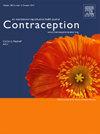计划生育协会临床建议:与母胎医学会联合制定
IF 2.8
2区 医学
Q1 OBSTETRICS & GYNECOLOGY
引用次数: 0
摘要
本文件是对计划生育协会 2010 年指南的修订,整合了有关新技术和新研究的文献,并探讨了有关诱导胎儿骤停的临床、医学和社会法律问题。目前尚无足够证据建议在孕前药物流产和程序性流产前常规诱导胎儿骤停。然而,在围孕期和胎儿存活后,在人工流产前诱导胎儿骤停,可避免发生虽不常见但严重的胎儿因心肺活动而意外流出的情况(最佳实践)。胎儿存活的定义非常复杂,因为它是一个生理连续体,受到妊娠持续时间以及其他多种临床因素和情况的影响;因此,提供胎儿骤停的确切妊娠持续时间将取决于环境和临床情况。如果可以在流产前诱导胎儿骤停,我们建议以患者为中心,根据每种独特的妊娠情况以及患者的信仰和优先考虑事项,就诱导胎儿骤停的风险和益处进行咨询(最佳实践)。我们建议临床医生根据每种药物的可用性、需要确定胎儿骤停的时间框架、临床医生的技术能力、偏好和实践等因素,确定特定临床情况下的最佳药物(最佳实践)。氯化钾、利多卡因和地高辛都是流产前诱导胎儿骤停的可接受药物。我们建议使用氯化钾(通过心内注射或膀胱内注射)或利多卡因(通过心内注射或膀胱内注射)(GRADE 2C),尽管胸腔内给予利多卡因也是可以接受的。如果无法实现心内或脐内注射,我们建议不使用氯化钾,以避免对孕妇造成意外用药风险,同时也因为没有足够的数据支持氯化钾通过胎儿体内其他部位的疗效(GRADE 1C)。在使用地高辛时,我们建议在胎儿体内给药(GRADE 1C),不过根据临床医生的技术能力和环境,羊膜腔内给药也是可以接受的。由于地高辛可能需要数小时才能诱发胎儿骤停,因此在必须快速确认胎儿骤停的情况下,应考虑使用其他药物。本文章由计算机程序翻译,如有差异,请以英文原文为准。
Society of Family Planning Clinical Recommendation: Induction of fetal asystole before abortion Jointly developed with the Society for Maternal-Fetal Medicine
This document serves as a revision to the Society of Family Planning's 2010 guidelines, integrating literature on new techniques and research and addressing the clinical, medical, and sociolegal questions surrounding the induction of fetal asystole. Insufficient evidence exists to recommend routine induction of fetal asystole before previable medication and procedural abortion. However, at periviable gestations and after fetal viability, inducing fetal asystole before abortion prevents the infrequent but serious occurrence of unanticipated expulsion of a fetus with cardiorespiratory activity (Best Practice). Defining viability is complicated as it represents a physiological continuum impacted by gestational duration along with multiple other individual clinical factors and circumstances; therefore, the exact gestational duration to offer fetal asystole will depend on the setting and clinical circumstances. If induction of fetal asystole before abortion is available, we recommend engaging in patient-centered counseling regarding the risks and benefits of induction of fetal asystole in the setting of each unique pregnancy scenario and the patient's beliefs and priorities (Best Practice). We recommend that clinicians identify the optimal pharmacologic agent to administer for a given clinical scenario based on factors such as availability of each agent; the time frame in which fetal asystole needs to be established; and clinicians' technical ability, preferences, and practice (Best Practice). Potassium chloride, lidocaine, and digoxin are all acceptable pharmaceutical agents to induce fetal asystole before abortion. To establish asystole rapidly, we suggest the use of potassium chloride (via intracardiac or intrafunic injection) or lidocaine (via intracardiac or intrafunic injection) (GRADE 2C), although intrathoracic administration of lidocaine may be acceptable. We recommend potassium chloride not be used if intracardiac or intrafunic location cannot be achieved to avoid the risk of accidental administration to the pregnant individual and because insufficient data support its efficacy via other intrafetal locations (GRADE 1C). When using digoxin, we recommend intrafetal administration (GRADE 1C), although intraamniotic administration may be acceptable depending on a clinician's technical ability and setting. Because digoxin may take several hours to induce asystole, an alternative agent should be considered in settings where fetal asystole must be confirmed rapidly.
求助全文
通过发布文献求助,成功后即可免费获取论文全文。
去求助
来源期刊

Contraception
医学-妇产科学
CiteScore
4.70
自引率
17.20%
发文量
211
审稿时长
69 days
期刊介绍:
Contraception has an open access mirror journal Contraception: X, sharing the same aims and scope, editorial team, submission system and rigorous peer review.
The journal Contraception wishes to advance reproductive health through the rapid publication of the best and most interesting new scholarship regarding contraception and related fields such as abortion. The journal welcomes manuscripts from investigators working in the laboratory, clinical and social sciences, as well as public health and health professions education.
 求助内容:
求助内容: 应助结果提醒方式:
应助结果提醒方式:


